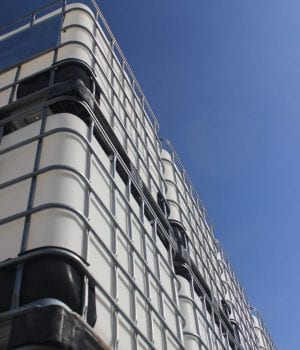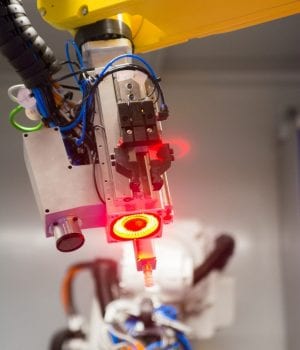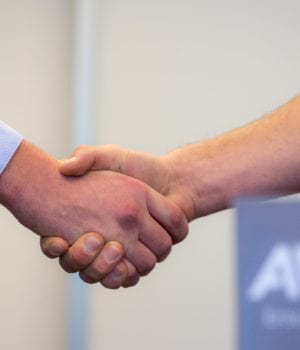Robots and software: heart of the factory of the future

Published on: Sep 19, 2018
Machine builder AWL has given advanced robotics and the growing role of software in industry a prominent place on its roadmap. Daniël Bottema, Research & Development manager, is working with his team on a fully automated factory, largely based on these technologies.
By: Dimitri Reijerman
It is not without reason that Bottema, who will speak during the WoTS about the factory of the future, is busy in AWL's research department. He says that companies like AWL simply have to innovate in order to meet the customer's requirements: “Increasingly, our customers tell us: we are no longer interested in two or three machines, we want to automate our entire factory. So you are talking about complete automation, including the surrounding logistics.”
Although in the past decades, many jobs have evaporated through mechanization and automation, Bottema says that nowadays, AWL customers are faced primarily with a shortage of qualified staff. “Many of our machines go to Poland, Hungary, the Czech Republic and Slovakia”, says the R&D manager. “Now, 56 million people live there, in thirty years’ time, that will be eight million fewer. In 2017, one third of the Czech companies indicated that they were unable to grow; they had to refuse orders because they could not find any more staff. Germany now has the lowest unemployment figure since 1980, and the US wants to fill 3.5 million factory jobs in the coming years. At least two million of those will not be successfully filled.”
Moreover, the introduction of the robot is already a given factor in modern factories, also in low-income countries. “China already has 63 robots per 10,000 employees. In three years’ time, that should be 150. There is an enormous push for robotization there, and things are getting increasingly simpler. We also see a growth of 15 percent per year in the US”, according to Bottema.
“Software is eating the world”
With a little less than 700 employees, AWL is able to respond with its R&D staff of 25 to that demand for an automated factory. Software development plays an important role here. “AWL employs mostly people with a mechanical engineering background, so with a mechatronics approach. But in 25 years time, we will have transformed into a software company. We can already see that now in my R&D department; 80 percent of what we develop is software-based. The most sophisticated things we develop are the software for controlling robots or for making machines more intelligent.”
Concerning the dominant role of software in industry, the R&D manager refers to an essay by Internet entrepreneur Marc Andreessen. In 2011, he wrote the famous sentence in The Wall Street Journal: “Why software is eating the world”. “In the past ten years, companies like Google and Uber have implemented that process. It will be our turn in the coming ten years”, says Bottema. “We are also taking on more and more software developers. We now employ front-end developers. That term was unknown to us a few years ago.
The modular factory of the future
At AWL, the R&D department envisages the factory of the future as an integrated entity based on a modular concept. Bottema: “Take for instance bin picking. Usually, an employee takes parts out of a crate and lays them in a jig. We will automate that too. For that we need vision technology, so that a robot knows what it should take out of the crate and be able to lay it accurately in the jig.”
“We are also working on self-driving vehicles. These are intelligent vehicles and can thus find their way. With these, we want to automate the entire factory logistics. Consider in this context the trolleys that run around in Amazon warehouses”, according to Bottema. “Collaborative robots (cobots) are also interesting. Humans and robots used to be kept strictly apart. In the future, the collaboration between humans and robots will change. This interaction has to become more natural. Consider these cobots in this respect.”
Safety is an issue for concern
The R&D manager acknowledges that cyber security is an even greater issue for concern in a completely automated factory. That is where the modular arrangement of AWL's vision comes in: “We want to build and use small Lego blocks. A block can be e.g. a welding process or some logistics. Keeping the modules small and communicating via a simple interface should make sure things don't soon run out of control.”
“As far as cyber security is concerned, we make every effort to make our machines safe; we use the same technology in them as in the banking sector. There is still a lot to do here, because IT is becoming increasingly interwoven with OT. We talk increasingly with our customer's IT branch. That was never necessary in the past", according to Bottema.
In spite of the fact that the introduction of robotics and far-reaching automated processes seem to be unstoppable, Bottema does not agree with the popular notion that robots will cause mass unemployment: “I don't believe that. I don't think things will go as fast as the prophets say. Countries with the most robots have the lowest unemployment.”
In conclusion, Bottema says he intends to pass on three things to his WoTS audience: to survive as a machine builder, you have to automate, and software is the decisive factor here. He thinks that the fact that many machine builders are wrestling with this is unavoidable. And finally: an automated factory does indeed become more complex, but it also teaches you to think bigger.
You will also like these blogs:.

New in oZone: Robot Safety Training – Free, practical, and essential for anyone working with robots

AWL Joins MHI’s The Robotics Group (TRG)

Meet the people | Seth McAndrew’s Journey from Electrical Technician to Shopfloor Supervisor



















